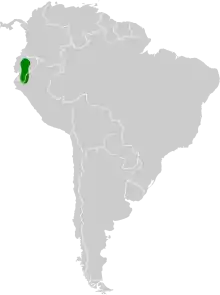Tube-lipped nectar bat
The tube-lipped nectar bat (Anoura fistulata) is a bat from Ecuador. It was described in 2005. It has a remarkably long tongue, which it uses to drink nectar. It additionally consumes pollen and insects.
| Tube-lipped nectar bat. | |
|---|---|
| Scientific classification | |
| Domain: | Eukaryota |
| Kingdom: | Animalia |
| Phylum: | Chordata |
| Class: | Mammalia |
| Order: | Chiroptera |
| Family: | Phyllostomidae |
| Genus: | Anoura |
| Species: | A. fistulata |
| Binomial name | |
| Anoura fistulata Muchhala, Mena-Valenzuela & Albuja, 2005 | |
 | |
Taxonomy and etymology
The tube-lipped nectar bat was first described in 2005.[2] The species name fistulata is derived from the Latin word fistula, meaning "tube". It refers to the bat's lower lip, which extends 3.3–4.8 mm beyond the upper lip and is rolled into a funnel shape. The exact function of the tube-lip is unknown.
Description
The bat has the longest tongue (8.5 cm) relative to its body size of any mammal. Its tongue is 150% the size of its overall body length. By convergent evolution, pangolins, the giant anteater (Myrmecophaga tridactyla), and the tube-lipped nectar bat all have a tongue that is detached from their hyoid bones and extend past the pharynx deep into the thorax.[3] This extension lies between the sternum and the trachea.
Biology and ecology
Despite its exceptionally long tongue, the tube-lipped nectar bat has a varied diet that includes nectar, pollen, and insects. This arrangement is possible due to its short jaw. The base of the tongue is in the bat's rib cage.[4] One plant, Centropogon nigricans, with its 80– to 90-mm-long corollae, is pollinated exclusively by this bat.
References
- Solari, S. (2018). "Anoura fistulata". IUCN Red List of Threatened Species. 2018: e.T136239A22001222. doi:10.2305/IUCN.UK.2018-2.RLTS.T136239A22001222.en. Retrieved 19 November 2021.
- Muchhala, Nathan; Patricio Mena; Luis Albuja (2005). "A New Species of Anoura (Chiroptera: Phyllostomidae) from the Ecuadorian Andes" (PDF). Journal of Mammalogy. 86 (3): 457–461. doi:10.1644/1545-1542(2005)86[457:ANSOAC]2.0.CO;2. ISSN 1545-1542. Archived from the original (PDF, Reprint) on 2015-09-23. Retrieved 2006-12-07.
- Muchhala, Nathan (2006). "Nectar bat stows huge tongue in its rib cage". Nature. 444 (7120): 701–2. Bibcode:2006Natur.444..701M. doi:10.1038/444701a. PMID 17151655. S2CID 4418648.
- Bryner, Jeanna. "Bat found to have longest licker". NBC News. Retrieved 2006-12-07.
